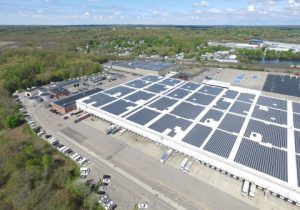
Fatburger opening in Shibuya, Tokyo, Japan by Masaya Fujita
Fatburger’s Merger with Parent Should Boost Share Liquidity, Pave Way for Bigger Accretive Acquisitions
Investors who bit into FAT Brands since its IPO may be feeling a little lethargic. But for those with a little patience, there should soon be reason to get fired up.
The restaurant franchiser, which owns and develops dining concepts such as Fatburger and Ponderosa Steakhouse, has seen its share price cut in half since listing as trading volumes remained depressed and investors shied away from new microcap issues. The company now trades at just 5.3 times the company’s 2018 adjusted earnings forecast and sports an 8.2{efe5d79870c08482e17ab0c97855f89429dac5f22c46026d3ca83573faec2208} dividend yield.
Soon, there may be a transaction that makes such a valuation and yield look too good to resist. The key is to simplify the company’s shareholder structure, which currently consists of 80{efe5d79870c08482e17ab0c97855f89429dac5f22c46026d3ca83573faec2208} ownership by Fog Cutter Capital Group (ticker: FCCG), a vehicle that is 75{efe5d79870c08482e17ab0c97855f89429dac5f22c46026d3ca83573faec2208} owned by the family office of FAT CEO Andrew Wiederhorn.
In an interview this week with RegAResearch, Mr. Wiederhorn said he intends to merge Fog Cutter with FAT Brands in 2018 or 2019. Importantly, he added that he will only pursue a deal that is beneficial to all FAT shareholders – not just Fog Cutter.
Here’s why this matters so much: First, the small number of tradeable FAT shares would increase dramatically after the transaction. Fog Cutter currently trades over the counter and the 25{efe5d79870c08482e17ab0c97855f89429dac5f22c46026d3ca83573faec2208} of its shares that aren’t owned by the Wiederhorns would effectively become FAT shares. The added liquidity is important because it would attract larger investors to consider owning the stock.
Second, FAT would no longer need to observe a rule keeping Fog Cutter’s ownership above 80{efe5d79870c08482e17ab0c97855f89429dac5f22c46026d3ca83573faec2208}. Currently, Fog Cutter is able to use its net operating losses (NOLs) to reduce FAT’s tax liability, but only if the parent’s ownership stays above that threshold. Those NOLs totaled about $70 million at the end of 2008 and have since increased, according to a person familiar with the matter.
But after a merger, the NOLs would simply be an asset that belongs to FAT. Without the 80{efe5d79870c08482e17ab0c97855f89429dac5f22c46026d3ca83573faec2208} restriction, FAT would be able to issue stock to complete highly-accretive mergers. As we wrote in this January piece, FAT is in a unique position to do deals that immediately boost its earnings, thanks to the elimination of overlapping costs with other franchisers it buys. FAT already has the balance sheet to get deals done, but with the added stock as a currency the potential is far greater.
Of course, investors should always beware of CEOs making deals that hurt minority shareholders. Look no further than the deal planned by Globalstar (ticker: GSAT), which very clearly enriches the company’s CEO at the expense of other shareholders.
But Mr. Wiederhorn has taken steps to demonstrate he will treat all shareholders fairly. For instance, the NOLs are worth less now than they were before the recent tax cuts. If he had pursued a merger, say, last fall, it might have involved a larger payment to Fog Cutter than it would today. By waiting, he has likely set up a more attractive deal for FAT.
What’s more, six members of FAT’s seven-director board are independent. Among the independent directors is the chairman, Edward Rensi, retired CEO of McDonald’s USA. While not an absolute guarantee, the board structure appears designed to protect all shareholders rather than just Mr. Wiederhorn.

Those who invest in FAT ahead of the merger don’t need to worry about going hungry. Mr. Wiederhorn has said the dividend will remain at current levels even if the company completes strategic acquisitions this year.
And remember, the core business of franchising is capital light, with franchisees bearing the financial burden of opening new locations. FAT collects an upfront franchise fee and then royalties, typically 5{efe5d79870c08482e17ab0c97855f89429dac5f22c46026d3ca83573faec2208} to 6{efe5d79870c08482e17ab0c97855f89429dac5f22c46026d3ca83573faec2208} of revenue both domestically and abroad.
Indeed, the international opportunity shouldn’t be overlooked as a source of steady future income. The company has about 300 locations with another 300 more in the works across 32 countries. And in many locations, FAT has only just begun to scratch the surface.
Consider Japan, where just this week the company opened its first restaurant in the Shibuya area of Tokyo, a highly-coveted location with about as much foot traffic as any shopping district in the world. According to a restaurant guest at the Tokyo location, customers were lined up well before the restaurant opened, keen to get their first orders in.
Such new openings abroad, along with plenty of runway at home, virtually ensures 10{efe5d79870c08482e17ab0c97855f89429dac5f22c46026d3ca83573faec2208} organic store growth annually. Since most costs are fixed, that new revenue flows to the bottom line.
With the Fog Cutter merger on the horizon and multiple engines of growth, investors have more reason than ever to own a piece of FAT.
Contact: Editor@RegAResearch.com







